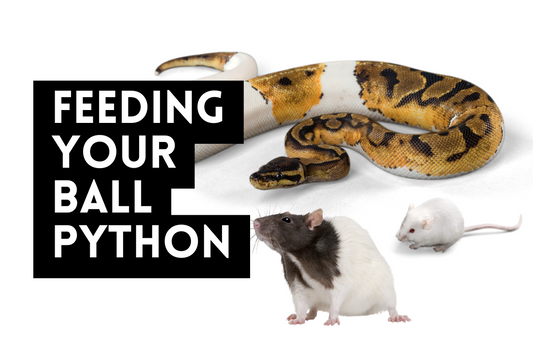Ball Python Care Guide
Share
Comprehensive Ball Python Care Sheet
So you bought a ball python….Now What?
Ball pythons (Python regius), also known as royal pythons, are one of the most popular pet snakes due to their manageable size, calm temperament, and ease of care. Native to the grasslands and forests of West and Central Africa, they thrive in environments that replicate their natural habitat. Ball pythons are known to live 20–30 years in captivity, with proper care.
Ball Python Enclosures
Ball pythons can be housed in traditional glass or PVC enclosures or specialized rack systems. Both options have pros and cons, depending on your space, budget, and the number of snakes you keep.
Rack SystemsSnake racks are popular among breeders and keepers with multiple snakes because they provide stable temperatures and humidity levels, but they offer less enrichment compared to larger enclosures. |
Glass Aquarium Style EnclosuresGlass aquariums provide more space than racks, but attention needs to be paid to covering the sides and back to help the animal feel secure in this style enclosure. The top will also need to be covered partially to maintain proper heat and humidity levels. |
PVC EnclosuresPVC reptile enclosures provide more space and security without compromising visibility, allowing for better environmental enrichment but may require more maintenance to regulate humidity and temperature. |
Enclosure Size
Juveniles: 10-20 gallon tank or a small tub in a rack system.
Adults: 40-gallon enclosure or a rack system tub large enough for the snake to fully stretch out. Larger enclosures (such as 48”x24”x18”) are recommended for active and larger ball pythons.
Temperature + Heating
Warm side: 88-92°F (31-33°C) for basking. Use a heat mat, radiant heat panel, or deep heat projector on one side of the enclosure, controlled by a thermostat.
Cool side: 76-80°F (24-27°C). This allows the snake to thermoregulate by moving between zones.
Night temperature: It can safely drop to around 75°F (24°C). Avoid temperatures below 70°F.
Use a reliable digital thermometer with probes to monitor temperatures at both the warm and cool ends of the enclosure. Along with a temperature gun.
Humidity
A high-quality Hygrometer will make monitoring and maintaining accurate humidity a breeze.
Maintain a humidity level of 50-60%. During shedding, increase humidity to 65-70%. This can be achieved by adding a larger water bowl, misting the enclosure as needed, or using a humid hide filled with moist sphagnum moss.
Lighting
Ball pythons are nocturnal and don’t require special lighting. However, providing 8-12 hours of UVA/UVB light can improve overall health and support natural behaviors.
Always use timers to ensure a consistent day-night cycle, and avoid using lights at night, which can disrupt their sleep cycle.
Substrate
Coconut husk like Reptichip or Go-4-Coco is the best choice and helps retain humidity but other popular choices include aspen shavings, cypress mulch, and butcher’s paper. These substrates are easy to spot clean. Avoid pine and cedar, as these are toxic to reptiles.
Hides & Enrichment
Provide at least two secure hiding spots—one on the warm side and one on the cool side of the enclosure.
Enrichment with artificial plants and decor can also enhance their environment, though it’s essential to ensure all materials are non-toxic and easy to clean.
Feeding
Feed appropriately sized frozen-thawed rodents. An appropriate size rodent shall not exceed the widest part of the snake’s body in size. The breeders should provide you with the last size fed but hatchlings can start on Mice fuzzies, and as the snake grows, you should transition to adult mice or small rats.
- Juveniles: Feed every 5–7 days.
- Adults: Feed every 7–14 days, depending on body condition.
Monitor the snake’s weight to ensure its maintaining a healthy condition.
Water
Provide a large water bowl for drinking and soaking. The water should be clean and changed regularly to prevent bacterial buildup. A healthy snake may soak in the water, especially when shedding.
Shedding
Ensure proper humidity to promote healthy shedding. Signs of shedding include dull skin and blue, cloudy eyes. After shedding, inspect the snake to ensure no skin or eye caps remain, especially around the tail.
Handling & Temperament
Ball pythons are typically docile but can be shy. Handle them gently, supporting their body fully. Avoid excessive handling during the first week in a new environment or after feeding to reduce stress.
Ball pythons are relatively low-maintenance pets, but they still require careful attention to their temperature, humidity, and feeding schedules. By providing the right environment and regular health checks, your ball python can live a long, healthy life.
Regular monitoring, husbandry adjustments, and enrichment will help ensure the snake thrives in captivity.












